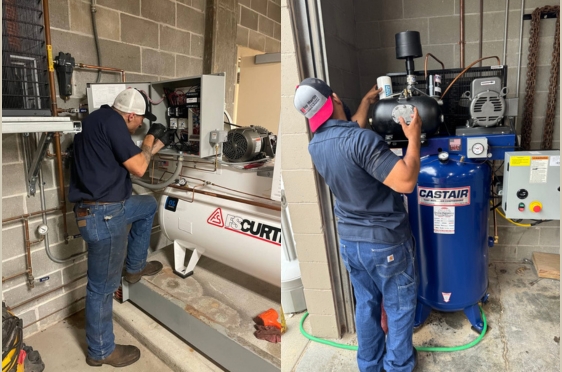So, there you are, ready to tackle a project. Tools lined up. Tank pressurized. You flip the switch on your air compressor and… nothing. No hum, no rattle, not even a cough. Just silence.
Frustrating? Oh, absolutely.
But here’s the good news: in most cases, it’s not a death sentence for your compressor. Whether you’re a DIY enthusiast, a weekend garage warrior, or running a small workshop, this guide will help you figure out why your air compressor won’t start — and what you can actually do to fix it.
Let’s get that tank back to life.
Common Reasons Your Air Compressor Won’t Start
Most no-start situations fall into three categories: electrical issues, mechanical problems, or environmental factors.
1. Electrical Issues
-
Tripped circuit breakers or blown fuses
Check your breaker panel — a reset might be all it takes. -
Undersized or long extension cords
A skinny, 50-foot cord isn’t helping. Use a short, heavy-duty one instead. -
Bad power switch or plug
Frayed wires, loose connections — any weak link can stop the show. -
Failed start capacitor
Hear a hum but no action? Your capacitor might be toast.
2. Mechanical Issues
-
Seized pump or motor
Happens when the unit sits unused too long or gets overworked. -
Low oil shutdown (for oil-lubed compressors)
Some compressors won’t run at all if oil levels drop too low. -
Stuck check valve or faulty unloader valve
Trapped pressure can prevent a restart. These parts release it — when they fail, the motor can’t kick in.
3. Environmental Factors
-
Cold weather
Thick oil or frozen parts can stop things cold. -
Dust and dirt buildup
Dirty filters = restricted airflow = low performance. -
Overloaded power circuits
Sharing an outlet with a heater, fridge, or tools? That’s a red flag.
Safety First: Before You Start Troubleshooting
Let’s not make a small issue worse. Always:
-
Unplug the compressor
-
Drain all tank pressure
-
Let it cool down
-
Wear gloves and safety glasses
Step-by-Step Troubleshooting Guide
Use this checklist — go in order:
-
Check the power source
Plug another device into the outlet. No power? That’s your answer. -
Inspect tank pressure
If it’s already at the cut-out pressure, it won’t start again until the pressure drops. -
Reset the overload switch
Many compressors have a reset button. Hold it for a few seconds. -
Listen for humming
Humming but no spin? Likely a capacitor issue. -
Manually test pump movement
Try rotating the motor shaft gently (if accessible). Stuck? The pump may be seized. -
Check oil levels
If your unit’s oil-lubricated, low oil can cause a shutdown. -
Inspect and clean the intake filter
A clogged filter can suffocate your compressor.
Easy Fixes You Can Try at Home
-
Reset the circuit breaker or replace a blown fuse
-
Replace a faulty capacitor
-
Clean or replace your air filter
-
Warm up your compressor in cold conditions
-
Check and clean the unloader or check valve
When to Call a Professional
Sometimes it’s beyond DIY. Call a pro if:
-
You smell burnt wiring or suspect motor failure
-
The pressure switch or internal board fails
-
You’ve tried all the basic fixes and it still won’t start
-
The unit’s under warranty — don’t void it
If you’re in the Omaha area and need expert help, we’ve got you covered.
Get professional air compressor repair in Omaha here.
How to Prevent Future Startup Problems
Avoid repeat issues by doing the basics right:
-
Drain the tank after every use
-
Use the correct, heavy-duty power cord
-
Replace intake filters regularly
-
Store the compressor in a moderate-temperature space
-
Keep oil levels where they should be
-
Check wires, belts, and fittings monthly
Final Thoughts
Most startup problems are fixable with a little patience and the right steps. Start with safety, follow a logical process, and don’t ignore early warning signs.
Fix it now, and it’ll serve you for years to come.

